Maximizing Yardage for Spinning Cotton
Susan Hector visits the blog today with an explanation of how she maximizes her yardage when spinning cotton on spinning tools that don’t have a lot of storage capacity for singles. Thanks so much for being here, Susan!
I spin a lot of cotton. Living in sunny and warm San Diego, it makes sense. I spin Sea Island cotton, Arizona short and long staple cotton, and naturally colored cotton from California and South America. I even grow my own cotton and spin it – I have over a dozen Acala cotton bushes in the back yard, watered with washing machine rinse water and fertilized with our compost. I dye cotton that is white and brown into the most astonishing range of indigo shades. I generally weave with the cotton I spin and dye, although I have done some knitted lace collars and scarves.
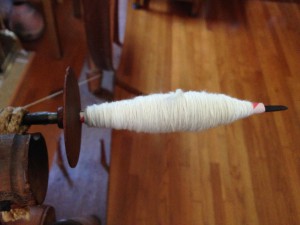
Singles on a driven spindle wheel. A paper straw quill was used on the spindle to hold the spun singles yarn.
I spin the cotton on a variety of tools: charkhas/driven spindle wheels, Akha spindles, feather weight top whorl spindles, a tahkli and other supported spindles – and also on fast flyer wheels. With the variety of tools I use to spin cotton, I needed to come up with a way to organize and maximize the plying process. My observation has been that when using a handspindle or driven-spindle wheel the amount of cotton you can get from one “spindle-full” is rather small. I was constantly emptying the spindle and had to manipulate relatively short lengths to store and ply. I had lots of quills and bobbins hanging around with resulting small skeins that were difficult to knit or weave with. Tangles and poor singles quality were also common when trying to ply from quills or spindles. I found a better way to do it.
Preparing the Singles
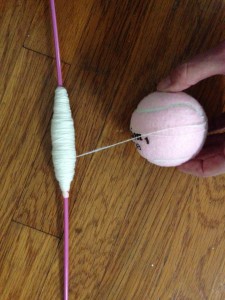
Removing the singles from the quill onto a ball. I use an old knitting needle to hold the quill.
First, I have to prepare the singles that I spin for the plying process. I (almost) always wind off from the spinning tool onto a bobbin or other holder before plying cotton to maintain tension, distribute the twist, and find weak spots. That’s easy enough from a handspindle. But when using a driven spindle wheel, such as a charkha, it is not practical to wind off a spindle directly when it is full of cotton yarn. Although some charkhas do allow the spinner to use interchangeable spindles, trying to ply directly from these has resulted in a nightmare of tangles and lost twist. If I am using a spindle wheel that does not have an interchangeable spindle system (such as a Great Wheel), I use a traditional method of putting a wrapper onto the spindle, and spinning onto that wrapper. The wrapper can be a piece of corn husk, sturdy drinking straw (with the base cut and slit to fit your spindle width as needed), or a firm twist of paper. Then, when ready to remove the singles, you just carefully pull off the wrapper. You have effectively created a quill full of singles yarn that you can wind off from without fear of tangling. I put mine on a knitting needle to wind off from the side of the quill.
For more detail on how to unwind cotton yarn from various sources, including a handspindle, refer to Stephenie Gaustad’s book, The Practical Spinner’s Guide to Cotton, Flax, Hemp (Interweave Press 2014). Ms. Gaustad included handspindles, charkas, and bobbins in her thorough and reasoned discussion.
Making a Plying Ball
OK, we have managed our singles so on to the plying. Whether it’s a driven-spindle wheel, a flyer wheel, or handspindles I usually have two or more spinning tools going at the same time and multiple projects underway. So I create a plying ball composed of singles from the various tools and projects to get the most yardage in my skeins (within reason, of course; you don’t want a huge skein with fine yarns). Then I ply from the ball, either on a larger handspindle or on a wheel. Thus I can combine several or many small batches from one or more spinning sources into a nice length skein which I can use for weaving or knitting.
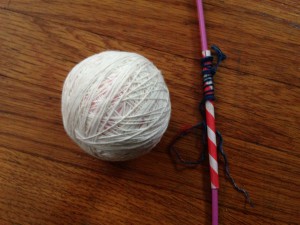
Singles successfully removed and wound onto a ball – this was one quill’s worth of singles.
Abby Franquemont discussed the use and value of plying from a multiple stranded plying ball in her book, Respect the Spindle (Interweave Press 2009). While not referring directly to cotton, she noted that this plying method, used by Andean spinners, reduces tangles, manages the yarn, and allows the spinner to carry the plying ball anywhere to use.
The methods described below keep the yarn safe, sound, and under tension until it is plied. If you try to ply directly from two spindles or quills you will have a nightmare of pigtails, kinks, and tangles – and breaks. Been there, done that. I tried two-end plying from a ball winder but I have found that this method does not keep the yarn under sufficient tension to retain the integrity of the yarn twist. I might use that method, which is somewhat like the Andean plying bracelet, for the small amount of yarn left at the very end of the spinning project.
Plying from 2 or more handspindles
A. Keeping the singles on the spindles.
Spin one spindle-full of cotton yarn. Set aside. Spin a second spindle full on another spindle. With one end from each, create a plying ball. One will run out first. Keeping the one that did not run out still attached to the plying ball, start again on another spindle. When it is full, join to the end still attached and ply. The original one will run out, and can be started over again. This can go on forever but don’t make your plying ball too large. Remember to overlap the singles while winding onto the ball and join firmly and securely when plying. You will need to make sure this join is secure by twisting the two ends together.
B. Wind off from 2 or more handspindles onto 2 separate balls.
Keep overlapping and joining the singles until you have a couple of ounces on each ball. Then, with a third ball and the two singles balls in bowls, wind a plying ball being careful to join the ends as you encounter them; give them a twist and a good overlap. Rewinding from the spindles first, before creating the plying ball, helps to distribute the twist and find any weak spots that are under twisted.
Plying from a driven-spindle wheel/charkha
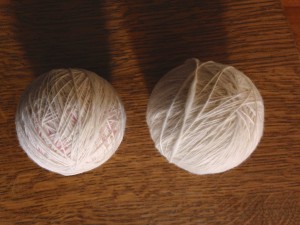
Partially full ball (left) and full ball of singles; I would add at least two more spindle’s worth of singles onto the partial ball before I create a plying ball.
If the wheel does not have interchangeable spindles, put a quill on the spindle (see above). Spin one quill full. Wind this off onto a tennis ball or some other source under tension. Spin another spindle, making sure that there is a little more on the second spindle than the first. Using the yarn on the ball and the yarn still on the spindle, create a plying ball. There should be some left on the spindle to join and begin again. You can also use Method 1 with a driven-spindle wheel; just keep adding to the ball as the spindles fill up, making sure to create a good join.
Using a flyer wheel
In this case, I can put a lot more singles yarn on the wheel bobbin. I fill up one bobbin, then wind it off onto a ball or a spare bobbin. Setting that aside, I fill up another bobbin at least as full as the first one. I can then create a plying ball using the first bobbin and the second one still on the wheel or wound off as well. As with Method 2, there should be some left on the wheel’s second bobbin to start up another batch.
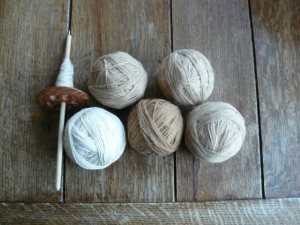
Plying balls of various cotton yarns ready to ply. Notice double strands on the balls. It is critical to wind the singles together onto the balls with even tension, removing any pigtails or tangles as you wind. Uneven tension between the two singles will result in poor plied yarn.
I put the balls in a bowl when I am winding or plying. My son made several shallow heavy ceramic bowls that are perfect for this purpose. I use tennis balls for winding off and plying but you could use felt balls. I recommend that the ball have a fuzzy surface to hold the layers of cotton yarn in place. When you are making the balls, either from singles or with two singles held together for plying, make sure you keep even tension and open up any pigtails or tangles. Hide these from your cat, by the way!
—————————————————————————————-
 Susan Hector is an anthropology professor at a local community college, and a consulting archaeologist for an environmental studies company. She and her husband spin in Old Town San Diego State Historic Park in period attire, as part of the park’s Fiber Arts Guild, which is a living history program. She has been spinning and weaving for over 30 years and can be found at SanDiegoFiberArtist@gmail.com.
Susan Hector is an anthropology professor at a local community college, and a consulting archaeologist for an environmental studies company. She and her husband spin in Old Town San Diego State Historic Park in period attire, as part of the park’s Fiber Arts Guild, which is a living history program. She has been spinning and weaving for over 30 years and can be found at SanDiegoFiberArtist@gmail.com.


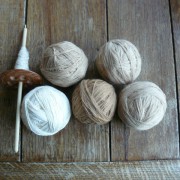

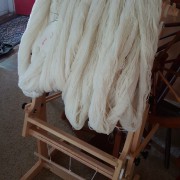
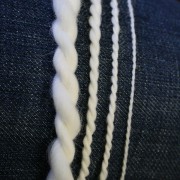
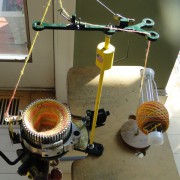



I have yet to develop any skill at spinning cotton, but these hints give me the urge to try. Great post!
Thank you, Audrey. I hope you do give it a try. I think it is probably easiest to learn on a Tahkli type supported spindle with a little hook on top. That way you can use the “park and draft” method to control the spin and draw out of the cotton fiber at your own speed. With a little practice you will find that suddenly you are making yarn. Hold the unspun fiber mass close to the hook, but gently so it drafts. Little bitty drafts at first, add twist to hold those short fibers together, then as you gain experience you can long draw the fiber which is the best way to make good progress. Have fun!
Thank you for sharing your story. I get involved with farmers and weavers of cotton here in India. There is a lady here uzuramma who has been producing wonderful cotton under the name Malkha. It would be great to host you in Hyderabad in case you are in India.